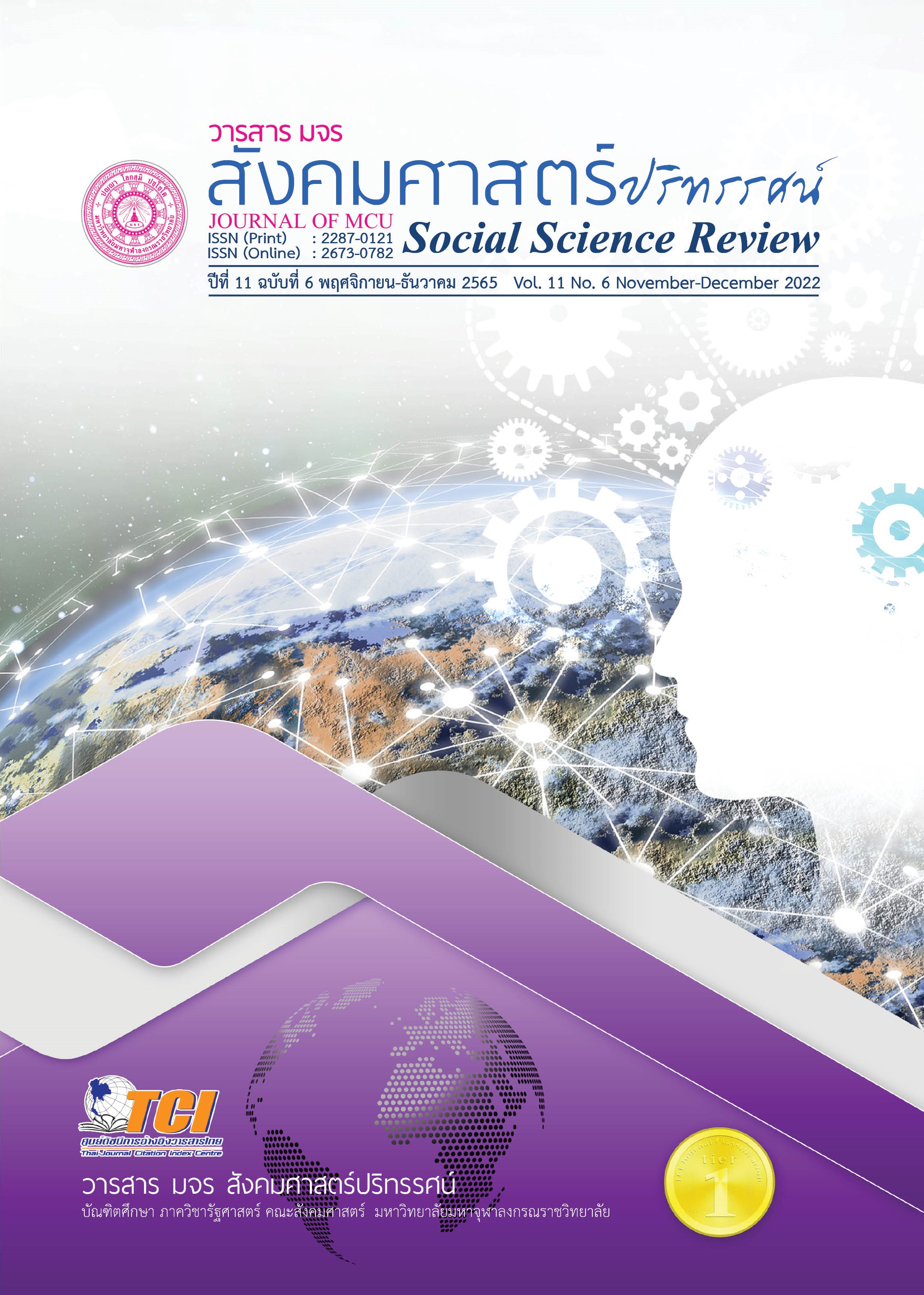การสร้างความผูกพันต่อองค์กรของพนักงานในช่วงสถานการณ์โควิด-19 กับการทำงานแบบปกติใหม่
คำสำคัญ:
ความผูกพันต่อองค์กร, โควิด-19, การทำงานแบบปกติใหม่บทคัดย่อ
บทความนี้เป็นบทความวิชาการที่มุ่งประเด็นให้เห็นว่า ความผูกพันของพนักงานต่อองค์กรเป็นคุณลักษณะสำคัญที่ทุกองค์กรต้องการให้มีโดยเฉพาะอย่างยิ่งในสภาวการณ์ปัจจุบัน การดูแลทุกข์สุขของพนักงานจะเป็นอีกหนึ่งเกราะป้องกันธุรกิจให้เติบโตได้อย่างยั่งยืน เพราะเมื่อพนักงานสามารถปฏิบัติงานอยู่ภายในองค์กรอย่างมีความสุข ก็พร้อมให้ความร่วมแรงร่วมใจที่จะเป็นกำลังสำคัญในการนำพาให้ธุรกิจสามารถฝ่าฟันอุปสรรคต่าง ๆ ที่เข้ามาได้ นับตั้งแต่เกิดการระบาดของเชื้อไวรัสโควิด-19 ในประเทศไทย หลายองค์กรหลายหน่วยงานได้ประกาศนโยบายการทำงานจากที่บ้าน หรือที่เรียกกันว่า Work from Home เพื่อลดความเสี่ยง เป็นการขานรับนโยบายของภาครัฐ โดยหวังว่าจะช่วยให้จำนวนตัวเลขผู้ติดเชื้อลดลง ดังนั้นองค์กรต่าง ๆ ควรให้ความสำคัญกับการสร้างความผูกพันต่อองค์กรของพนักงานในช่วงสถานการณ์โควิด-19 เพื่อรักษาบุคลากรหรือพนักงานที่มีความรู้ ความสามารถ เพื่อลดความเสี่ยงความเสียเปรียบทางธุรกิจ และค่าใช้จ่ายในการสรรหา คัดเลือกพนักงานใหม่ โดยสามารถทำได้ด้วยการรักษาและสร้างความผูกพันในด้านที่ไม่ใช่ตัวเงิน (Engagement With Non-Financial) และการสร้างแรงจูงใจจากการตอบแทนที่เป็นตัวเงินและผลประโยชน์เกื้อกูล (Motivation With Financial – Compensation & Benefit) ในการสร้างความผูกพันของพนักงานต่อองค์กรนี้ ยังส่งผลต่อประสิทธิภาพการปฏิบัติงานของทั้งตัวบุคคลและองค์กรให้เพิ่มสูงขึ้นอีกด้วย
เอกสารอ้างอิง
กนกพร กระจางแสง และวิโรจน์ เจษฎาลักษณ์. (2560). อิทธิพลของแรงจูงใจในการทำงานและการสนับสนุนจากองค์กรที่ส่งผลต่อคุณภาพในการปฏิบัติงานผ่านความผูกพันต่อองค์กรของบุคลากรโรงพยาบาลนครธน. วารสารวิชาการมหาวิทยาลัยธนบุรี, 11(26), 116-129.
กฤษฎา แสวงดี. (2551). การศึกษาอุปทานกำลังคนพยาบาลวิชาชีพในประเทศไทย. กรุงเทพฯ: สำนักการพยาบาลกรมการแพทย์ กระทรวงสาธารณสุข.
จิรประภา อัครบวร. (2558). เครื่องมือการวินิจฉัยยความอยู่ดีมีสุขและความผูกพันของบุคลากร. กรุงเทพฯ: สำนักงานคณะกรรมการส่งเสริมสุขภาวะและสมาคมการจัดการงานบุคคล
ณรงค์กร มโนจันทร์เพ็ญ. (2564). สถานการณ์โควิดระบาดทั่วโลก. สืบค้น 20 ตุลาคม 2564, จาก https://thestandard.co/coronavirus-201064/.
ดาวิษา ศรีธัญรัตน์. (2562). ระบบงานทรัพยากรมนุษย์เชิงกลยุทธเพื่อการพัฒนาองค์การ. กรุงเทพฯ: สถาบันบัณฑิตพัฒนบริหารศาสตร์.
นงนุช วงษ์สุวรรณ. (2550). การบริหารทรัพยากรมนุษย์. จันทบุรี: โรงพิมพ์อนันตศิลป์.
ปรียาพร วงศ์อนุตรโรจน์. (2542). จิตวิทยาการบริหารงานบุคคล. กรุงเทพฯ: ศูนย์ส่งเสริม.
ฝ่ายแผนงานและพัฒนาระบบกองบริหารทรัพยากรบุคคล. (2562). รายงานการสำรวจความผูกพันต่อองค์กรของบุคลากรในสำนักงานปลัดกระทรวงสำนักงานรัฐมนตรี. กรุงเทพฯ: กระทรวงคมนาคม.
สุขมิตร ก่อมณี. (2564). การพัฒนาศักยภาพกำลังคนด้านซอฟต์สกิล. วารสารศึกษาศาสตร์ มหาวิทยาลัยบูรพา, 33(1), 117-145.
Gandhi, V. (2020). As COVID-19 Continues Employee Are Feeling Less Prepared. Retrieved September 30, 2021, from https://shorturl.asia/kKUSl.
Herzberg, F. et. Al. (1959). The Motivation of Work. New York: John Wiley & Sons.
Hewitt Associates. (2004). Research Brief: Employee Engagement Higher at Double Digit Growth Companies. Retrieved October 30, 2021, from http://www.hewitt.com
Mathis, R.L. & J. H. Jackson. (2011). Human Resource Management (13th ed.). USA: South-Western Cengage Learning.
Novabizz. (2015). การบริหารทรัพยากรมนุษย์ The Human Resources Management. สืบค้น 1 ตุลาคม 2564, จาก https://www.novabizz.com/NovaAce/Manage/การบริหารทรัพยากรมนุษย์.html
Porter and others. (1974). Organizational Commitment Job Satisfaction and Turnover Among Psychotic Technicians. Journal of Applied Psychology, 59(5), 603-609.
Vance, R. J. (2006). Employee Engagement and Commitment. VA: The SHRM Foundation.
ดาวน์โหลด
เผยแพร่แล้ว
รูปแบบการอ้างอิง
ฉบับ
ประเภทบทความ
สัญญาอนุญาต
ลิขสิทธิ์ (c) 2022 วารสาร มจร สังคมศาสตร์ปริทรรศน์

อนุญาตภายใต้เงื่อนไข Creative Commons Attribution-NonCommercial-NoDerivatives 4.0 International License.
เพื่อให้เป็นไปตามกฎหมายลิขสิทธิ์ ผู้นิพนธ์ทุกท่านต้องลงลายมือชื่อในแบบฟอร์มใบมอบลิขสิทธิ์บทความให้แก่วารสารฯ พร้อมกับบทความต้นฉบับที่ได้แก้ไขครั้งสุดท้าย นอกจากนี้ ผู้นิพนธ์ทุกท่านต้องยืนยันว่าบทความต้นฉบับที่ส่งมาตีพิมพ์นั้น ได้ส่งมาตีพิมพ์เฉพาะในวารสาร มจร สังคมศาสตร์ปริทรรศน์ เพียงแห่งเดียวเท่านั้น หากมีการใช้ภาพหรือตารางหรือเนื้อหาอื่นๆ ของผู้นิพนธ์อื่นที่ปรากฏในสิ่งตีพิมพ์อื่นมาแล้ว ผู้นิพนธ์ต้องขออนุญาตเจ้าของลิขสิทธิ์ก่อน พร้อมทั้งแสดงหนังสือที่ได้รับการยินยอมต่อบรรณาธิการ ก่อนที่บทความจะได้รับการตีพิมพ์ หากไม่เป็นไปตามข้อกำหนดเบื้องต้น ทางวารสารจะถอดบทความของท่านออกโดยไม่มีข้อยกเว้นใดๆ ทั้งสิ้น





